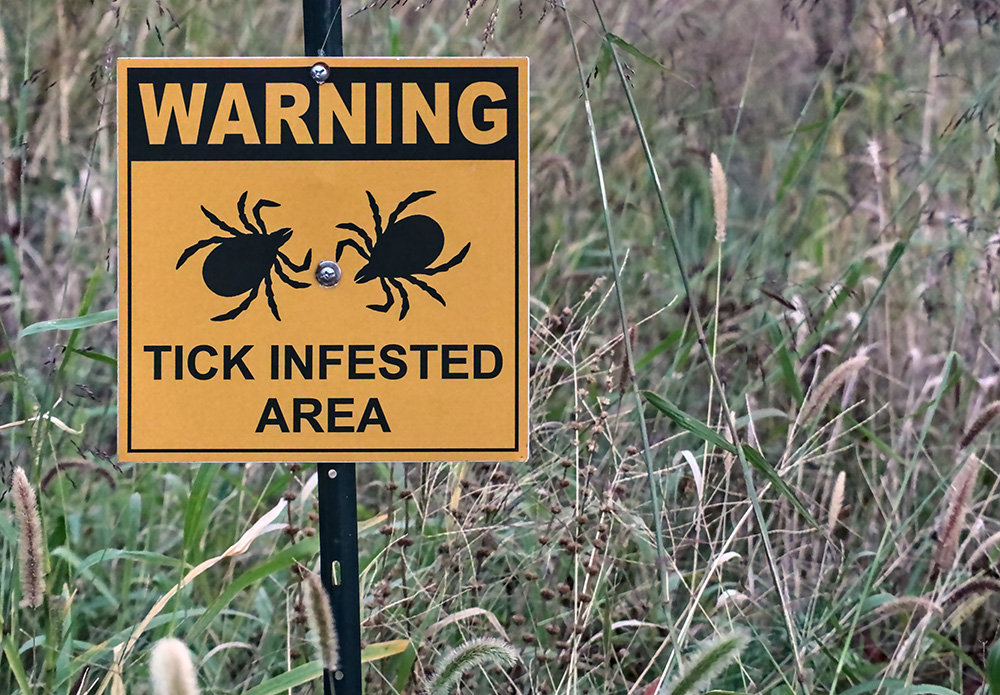Tick, Tick, Tick: Warm weather creates opportunity for blood-sucking parasite

K-State entomologist provides tips for preventing tick diseases in humans and animals
‘Tis the season for warmer temperatures, getting outdoors and playing in green, grassy fields – all fun, but also conditions that favor a blood-sucking parasite that preys on humans, pets and livestock.
Due to the early warming weather, Kansas State University entomologist Cassandra Olds said ticks have already been found around Manhattan in mid-March.
Many tick bites are harmless, but some ticks can transmit pathogens causing diseases such as Lyme disease and Rocky Mountain spotted fever. Olds said that avoiding tick bites is the first level of defense.
“Be careful when you’re outdoors, especially when you’re in an area with long grass,” she said. “Ticks need to be protected from the elements, so they like to be in the grass and leaf litter, but then they come out looking for a meal.”
When in tall grassy areas, Olds suggests tucking pants into socks, and shirts into pants to limit tick access to your skin. You can even duct tape shirt sleeves to skin.
“You just really want to limit the entry points where a tick can get in,” she said. “Then, once you’re back indoors, take off your clothes, put them in the wash and do a full body check.”
If a tick is found on the body, and it is not embedded you can pick it off to remove. If it has attached, Olds suggests using the thumb and forefinger to pull it away from the body with steady but firm pressure.
Olds said that once a tick finds a host, it must penetrate the skin, secure its mouth parts and initiate feeding. It takes about 24 to 48 hours. She said that if ticks can be repelled, prevented from attaching or killed during this period, then it reduces the chance that it will have transmitted a pathogen.
“I always get people freaked out when I say this, but you should then store that tick in a Ziploc bag in the freezer for two weeks,” she said. “If by chance that tick was carrying (a pathogen) and you start getting flu-like symptoms, or feeling sick, you can then take that tick with you to your doctor or send to (K-State’s Department of Entomology) for identification. If we know what tick species it is, it narrows down what you might be infected with, which gives us a head start for treatment.”
The tick species that most commonly infest people and domestic animals in Kansas are the American dog tick, lone star tick, winter tick, and the blacklegged tick (or deer tick).
“The American dog tick is one that is a big problem because it can transmit a nasty pathogen called the Rocky Mountain spotted fever to dogs and humans,” Olds said.
The American dog tick can also induce tick paralysis, which is caused by components in tick saliva. Tick paralysis occurs more frequently in children and smaller animals and can often be reversed by removing the tick in a timely manner.
The lone star tick is one that people come across more commonly in Kansas. The female tick is brown, with a white spot on it. The male is similar-looking, but without the white spot.
The lone star tick can transmit several pathogens, but is also known to cause the malady known as alpha-gal syndrome. It’s an allergy to mammalian food products or items with animal additives, including several medications.
Full descriptions and pictures of ticks common to the Sunflower State are available in a publication from K-State Research and Extension, titled ‘Ticks in Kansas,’ which can be accessed online.
To protect dogs, cats and livestock, Olds said a regular application of acaricides – which are pesticides used to kill ticks and mites – may be necessary. She suggests consulting with a veterinarian for the best recommendation to protect animals.
More information is also available at local extension offices in Kansas.
PHOTO: Warning tick infested area sign in a grassy field. (Adobe Stock │ #690377558 – Yuriy T)



